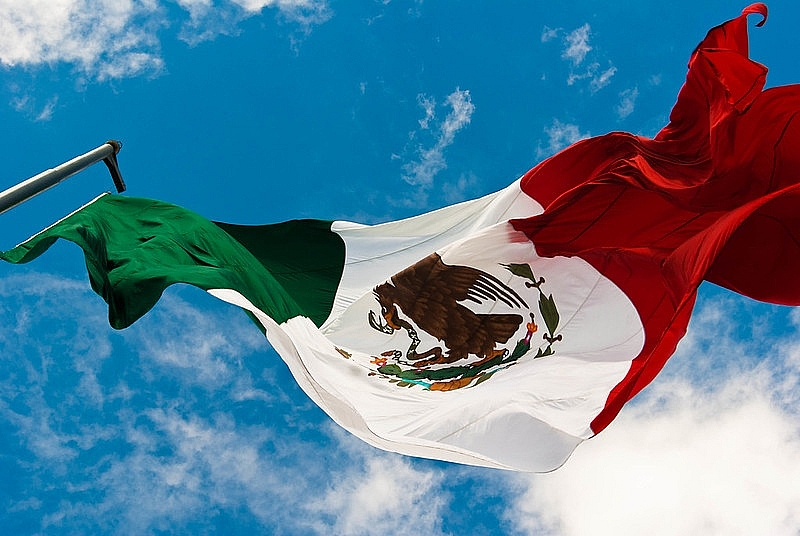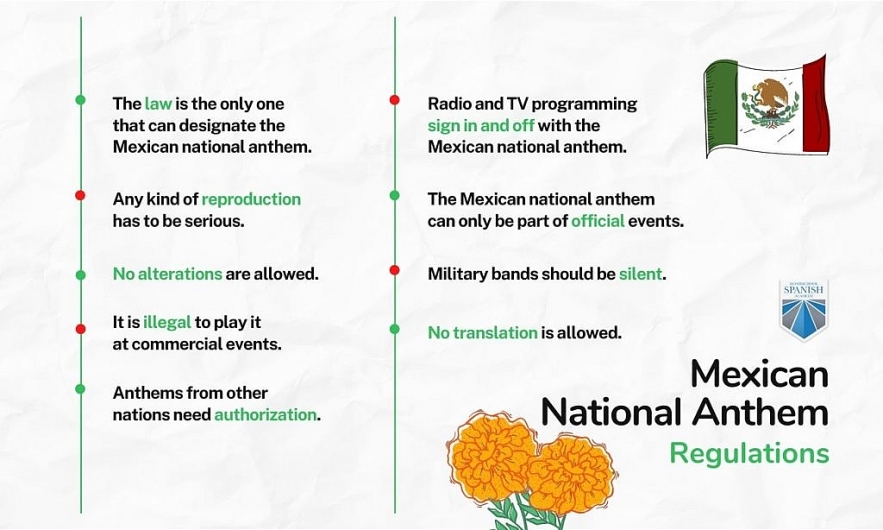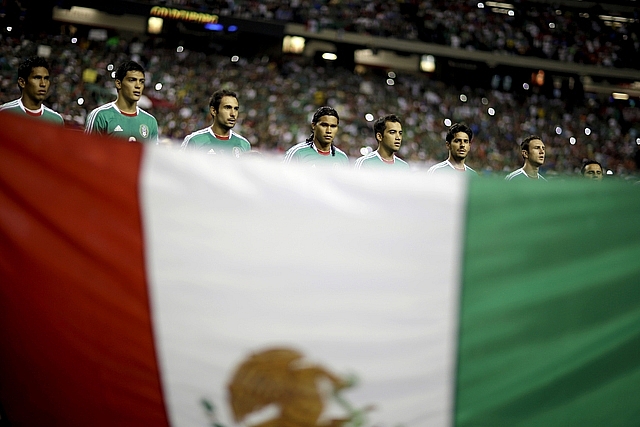Mexican National Anthem: Full Lyrics In Spanish & English Version, History
 How to Make Mexican Molletes with Easy Steps How to Make Mexican Molletes with Easy Steps |
 Top 10 Best Mexican Restaurants in Las Vegas: Breakfast, Lunch and Dinner Top 10 Best Mexican Restaurants in Las Vegas: Breakfast, Lunch and Dinner |
 |
| What Is National Anthem Of Mexico: History, Lyrics In Spanish and English. Photo Flickr |
What is Mexico’s national anthem?
The national anthem of Mexico is known as Himno Nacional Mexicano in Spanish.
Also known as "Mexicanos, al grito de guerra" (Mexicans, at the scream of war). Francisco Gonzalez Bocanegra won a federal contest with his original 1853 lyrics to the anthem. The lyrics were inspired by the Mexican army's glorious achievements in war and included a call to arms for the nation as a whole. Bocanegra asked Jaime Nuno to write music to go along with the text, and Nuno finished composing the music in 1854. The same year, the song officially became the country's anthem.
There were eleven verses to the original song. However, the official national anthem of Mexico is a condensed version of this song, similar to that of most other countries. The first chorus and the fifth, sixth, and tenth stanzas were chosen for use as the official national anthem in 1943. The national anthem is sometimes played in a shortened format at athletic events and on television and radio. Since it promotes national solidarity, the Mexican people take their national anthem very seriously. Others have referred to the anthem as a representation of "Mexican identity." When the national anthem is not played properly, the government can and will issue fines.
Many historians consider the Mexican national anthem as one of the most beautiful in the world. By reading or hearing it you can guess it is about war, but the central theme is really the peace that comes afterward and how it praises the importance and honor of defending the motherland.
Pre-national anthemOriginally, Italians Claudio Linatti y Florencio Galli were pushing for a song to be adopted as the national anthem; the lyrics were written by Cuban José Mara Heredia, and the music was composed by German Ernest Ferdinand Wezel. A play by José M. Lozada set to music by Carlos Bochsa premiered in Mexico's national theater in 1850, followed by a play by Henri Herz that also premiered in the same year. In 1853, President Antonio López de Santa Anna declared a federal contest for the development of the lyrics and melody of the country's national anthem due to the lack of consensus on the subject. |
How was Mexican National Anthem composed?
 |
| Photo Flickr |
In 1853, in honor of the final military clash against the Spanish Empire in Mexico at Tampico, President Santa Ana—who many still believe responsible for the territory loss—organized a competition to create an epic. The song with the most votes became Mexico's national anthem.
The Lyrics
The Mexican poet Francisco González Bocanegra, age 30, was hesitant to take part. He fancied himself a love poet, thus no amount of persuasion from his loved ones seemed to sway him.
His fiancée, Guadalupe González del Pino, enlisted the aid of her father to trick him into entering a bedroom. She barricaded the door behind her and wouldn't let him go until he had written something for the contest. She allegedly left him food and water under his door and decorated his room with images of Mexico victories to motivate him.
He worked on the poem for four hours and emerged with a ten-stanza entry that earned Guadalupe's stamp of approval and was competition-worthy. Thus, his work was chosen as the winner by the panel of judges.
Years later, following a parade of unsuccessful anthems, President Porfirio Diaz defended and popularized this one as the definitive national anthem of Mexico.
After almost a century, the government of Mexico removed six stanzas from the official Mexican national song, keeping only the first, fifth, sixth, and tenth stanzas, as well as the chorus, for which Bocanegra never received any sort of acknowledgment. It's because some of them glorified historical figures from Mexico who went on to become monsters and traitors. They included the first Emperor of Mexico, Agustn de Iturbide, and his consort, Antonio López de Santa Ana. This is why the Mexican national anthem was initially met with ambivalence.
The most well-known line is the first one, "Mexicanos al grito de guerra" (Mexicans at the scream of war). Although all verses contain references to war, a careful reading (the full version is available in the Mexican national anthem lyrics section) reveals how much the people of Mexico yearn for peace even as they remind the world that "a soldier in every son" will defend the motherland should the enemy dare to invade.
The Music
A second contest was launched, and the winning entry featured music composed by Catalan musician Jaime Nunó to go along with Bocanegra's text. During the time, Nunó was in charge of the King of Spain's band and the director of the Queen's Regimental Band.
He was invited to conduct the Mexican military bands after making friends with President Santa Ana of Cuba during one of his visits there. Nuno was in Mexico at the same time as the Mexican national anthem contest. He wrote a classically-quality song named "God and Freedom" (Dios y libertad).
Both Jaime Nunó and Francisco González Bocanegra are buried in Mexico City's Cemetery of the Illustrious People (Rotonda de las Personas Ilustres).
Mexico’s National Anthem Lyrics In Spanish and English
| Estribillo: Mexicanos, al grito de guerra El acero aprestad y el bridón, Y retiemble en sus centros la tierra Al sonoro rugir del cañón. | Chorus: Mexicans, when the war cry is heard, Have sword and bridle ready. Let the earth's foundations tremble At the loud cannon's roar. |
| Estrofa 1: Ciña ¡oh Patria! tus sienes de oliva De la paz el arcángel divino, Que en el cielo tu eterno destino, Por el dedo de Dios se escribió; Mas si osare un extraño enemigo, Profanar con su planta tu suelo, Piensa ¡oh Patria querida! que el cielo Un soldado en cada hijo te dio. | Stanza 1: May the divine archangel crown your brow, Oh fatherland, with an olive branch of peace, For your eternal destiny has been written In heaven by the finger of God. But should a foreign enemy Dare to profane your soil with his tread, Know, beloved fatherland, that heaven gave you A soldier in each of your sons. |
| Estrofa 2: Guerra, guerra sin tregua al que intente ¡De la patria manchar los blasones! ¡Guerra, guerra! Los patrios pendones En las olas de sangre empapad. ¡Guerra, guerra! En el monte, en el valle Los cañones horrísonos truenen Y los ecos sonoros resuenen Con las voces de ¡Unión! ¡Libertad! | Stanza 2: War, war without truce against who would attempt to blemish the honor of the fatherland! War, war! The patriotic banners saturate in waves of blood. War, war! On the mount, in the vale The terrifying cannon thunder and the echoes nobly resound to the cries of union! liberty! |
| Estrofa 3: Antes, patria, que inermes tus hijos Bajo el yugo su cuello dobleguen, Tus campiñas con sangre se rieguen, Sobre sangre se estampe su pie. Y tus templos, palacios y torres Se derrumben con hórrido estruendo, Y sus ruinas existan diciendo: De mil héroes la patria aquí fue. | Stanza 2: Fatherland, before your children become unarmed Beneath the yoke their necks in sway, May your countryside be watered with blood, On blood their feet trample. And may your temples, palaces and towers crumble in horrid crash, and their ruins exist saying: The fatherland was made of one thousand heroes here. |
| Estrofa 4: ¡Patria! ¡Patria! tus hijos te juran Exhalar en tus aras su aliento, Si el clarín con su bélico acento, Los convoca a lidiar con valor: ¡Para ti las guirnaldas de oliva! ¡Un recuerdo para ellos de gloria! ¡Un laurel para ti de victoria! ¡Un sepulcro para ellos de honor! | Stanza 4: Fatherland, oh fatherland, your sons vow To give their last breath on your altars, If the trumpet with its warlike sound Calls them to valiant battle. For you, the olive garlands, For them, a glorious memory. For you, the victory laurels, For them, an honored tomb. |
Mexican National Anthem Regulations
 |
| Photo Spanish Academy |
Here are the regulations according to the Law on National Arms, Flag, and Anthem (Ley sobre el Escudo, la Bandera y el Himno Nacionales) that apply to Mexico’s National Anthem:
The law is the only one that can designate the Mexican national anthem.
According to the law, it should always be in the National Library as well as the National Museum of History.
Any kind of reproduction has to be serious.
Any time people are singing Mexico’s national anthem, they have to ensure it is with absolute respect and solemnity.
No alterations are allowed.
No one can alter it in any way, nor the lyrics, the music or the tempo.
It is illegal to play it at commercial events.
The national anthem cannot be used for commercial purposes. The authorities actually took it out of the movie Jumanji when it came to Mexico.
Anthems from other nations need authorization.
The law also forbids you from playing or interpreting other nation’s anthems unless you have proper authorization from the government. When in this situation, the Mexican national anthem should be played first.
Radio and TV programming sign in and off with the Mexican national anthem.
When it comes to TV, pictures of the flag should accompany the anthem.
The Mexican national anthem can only be part of official events.
Events with official authorization of cultural, civic, or sports categories.
Military bands should be silent.
When the choir is singing the Mexican national anthem, military bands must keep silent at all times.
No translation is allowed.
You cannot translate it to other languages unless they are Mexican indigenous.
If anyone is to play or sing the Mexican national anthem incorrectly or without the solemnity it deserves, that person will receive a fine from the government. It has happened more than once on national TV while at a great event. This offends most people who normally express their disapproval towards the musician on stage.
Mexican National Anthem Traditions
 |
| Photo Las Vegas Review |
Everybody attending or watching from home should rise and sing the Mexican national song. All headscarves must be removed and a salute given.
We do not, like many other countries, sing our national anthem with our right hands over our hearts, but rather at the center of our chests, with the four fingers straight and together pointing left and the thumb pointing to the floor.
A quick technique to see if someone is just claiming to be Mexican is to ask them to sing the Mexican national song. In a now-famous event, four individuals in Tokyo were apprehended after falsely claiming to be Mexican. They were unable to perform the national anthem when asked by Japanese authorities. That's when the local authorities realized the Mexican passports they'd been using weren't real and that the travelers were actually Colombians.
 Why Does National Anthem of Spain Have No Lyrics and Unofficial Lyrics Why Does National Anthem of Spain Have No Lyrics and Unofficial Lyrics Did you know that there are no words to Spain’s national anthem? Read on to know why national anthem of Spain has no lyrics. |
 What is The National Anthem Of Russia: English Version, Original Lyrics, History and Facts What is The National Anthem Of Russia: English Version, Original Lyrics, History and Facts The Russian national anthem is known and admired all over the world for many reasons. Read on to see the lyrics and the song's history. |
 What is The National Anthem of France: English Version, Original Lyrics And History What is The National Anthem of France: English Version, Original Lyrics And History Let's learn about history of national anthem of France and sing along with lyrics below in French and English. |
























